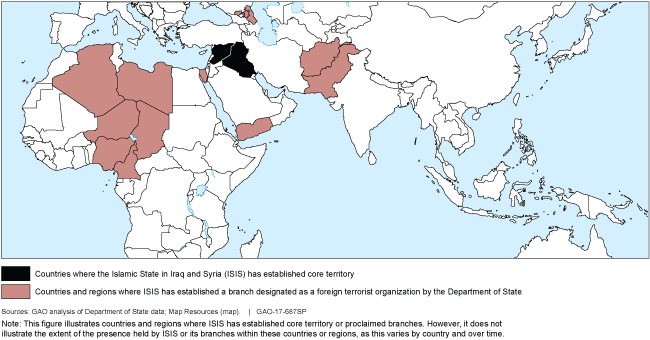Countering ISIS and Its Effects: Key Issues for Oversight
Fast Facts
As the Islamic State of Iraq and Syria emerged, it seized territory in Iraq and Syria, and established branches and launched terror attacks in a number of countries. The U.S. government, working with international partners, undertakes a range of efforts to counter the group.
We identified 9 key issues related to U.S. counter-ISIS efforts. Among the issues:
Assisting and equipping Iraqi and Syrian opposition forces combatting ISIS
Providing humanitarian and governance assistance to Iraqis and Syrians
Disrupting ISIS's branches and networks in various countries, including its financing and propaganda
Mitigating threats to homeland security
Foreign Countries and Regions Where the Islamic State of Iraq and Syria Has Established Core Territory and Official Branches

Map showing countries and regions where ISIS is located in Africa, Eurasia, and the Middle East.
Highlights
What GAO Found
Given the importance of countering the Islamic State of Iraq and Syria (ISIS) as a U.S. national security priority and the level of resources expended to counter ISIS and address humanitarian and other effects related to these efforts, we have identified a number of key issues for the 115th Congress to consider in developing oversight agendas and determining the way forward. Significant oversight will be needed to help ensure visibility over the cost and progress of these efforts. The enclosures in this report suggest specific areas for oversight on the following topics: (
- Training and Equipping Vetted Iraqi Forces. Iraq's security forces collapsed in many areas under pressure from ISIS in 2014, and the United States undertakes efforts to regenerate Iraq's security forces and develop their ability to conduct offensive operations against ISIS to not only reclaim territory currently controlled by ISIS but also retain control of that territory.
- Training and Equipping Vetted Syrian Opposition. In 2013 ISIS emerged as a major force in Syria, taking control of parts of the country, and the United States is seeking to enhance the ability of the vetted Syrian opposition to defend its population from ISIS and promote the conditions for a negotiated settlement to end the Syrian conflict.
- Advising, Assisting, and Enabling Forces in Iraq and Syria. U.S. efforts to strengthen the capabilities of Iraq's security forces and vetted Syrian opposition forces include providing types of military support, such as airstrikes and intelligence, to partner Iraqi and Syrian forces engaged in combat with ISIS.
- Humanitarian Assistance to Iraqis and Syrians. The ongoing conflicts in Iraq and Syria have created urgent humanitarian situations in both countries and in the region, as people affected by the conflicts seek relief in neighboring countries.
- Governance and Stabilization Assistance to Iraq and Syria. Iraq and Syria have been destabilized by conflict and other factors, and will likely need assistance to establish more inclusive government structures and stable communities, as well as to counter ISIS and reclaim territory in Iraq.
- Addressing the Spread of ISIS Internationally. Beyond Iraq and Syria, ISIS represents an international threat, both through its branches and networks in other countries and foreign fighters leaving the battlefields in Iraq and Syria.
- Disrupting ISIS's Financing. ISIS's financing capabilities both within Iraq and Syria and to its branches and networks worldwide present unique challenges, and the group may adapt its funding approaches in response to changing conditions in Iraq and Syria and beyond, likely requiring an evolving counter-finance response.
- Countering ISIS's Messaging Efforts. ISIS produces messaging to intimidate the global population, recruit followers, promote its violent extremist ideology, and encourage terrorist attacks, and as the group loses control of physical territory in Iraq and Syria, it may increase its messaging efforts to encourage supporters to conduct attacks in their home countries.
- Mitigating Threats to Homeland Security. Violent extremist threats against the homeland come from a range of groups and individuals, including international terrorist groups, such as ISIS, and domestic terrorists and homegrown violent extremists in the United States.
Why GAO Did This Study
The emergence of the Islamic State of Iraq and Syria (ISIS) has undermined stability in Iraq, Syria, and the broader Middle East and poses a threat to international peace and security, including to the United States. Since its emergence, ISIS has declared branches and established networks in other countries and attracted an international network of supporters, launching acts of violence and terrorism in various countries throughout the world. U.S. officials have noted that, in response to territorial losses on the ground in Iraq and Syria, the threat of ISIS-inspired attacks may grow, including on Western targets such as the United States. In September 2014, the White House issued the U.S. Strategy to Counter the Islamic State of Iraq and the Levant (ISIL) with the goal to degrade and destroy ISIS through an approach that included working with regional and international partners.
For more information, contact Charles M. Johnson, Jr. at 202-512-7331 or johnsoncm@gao.gov.
